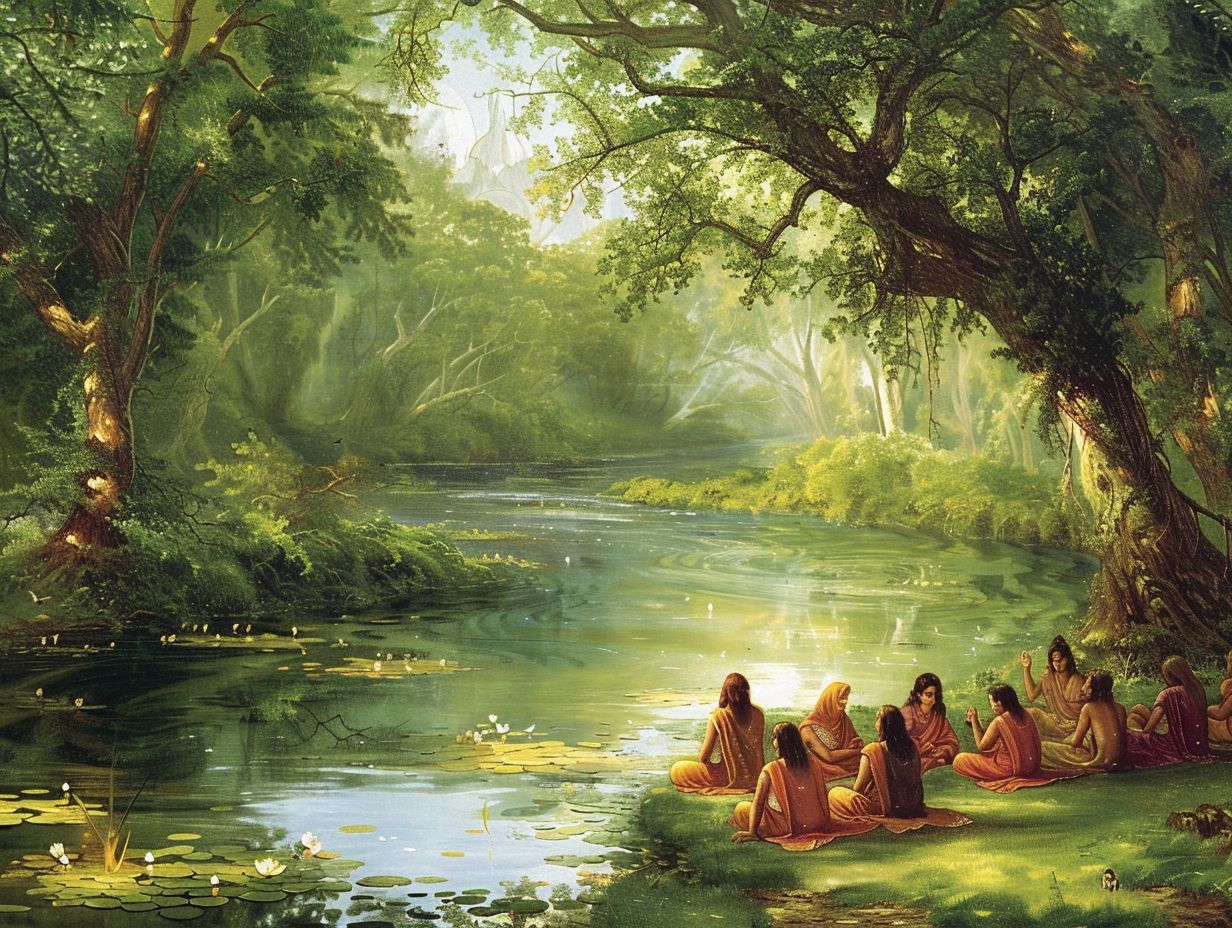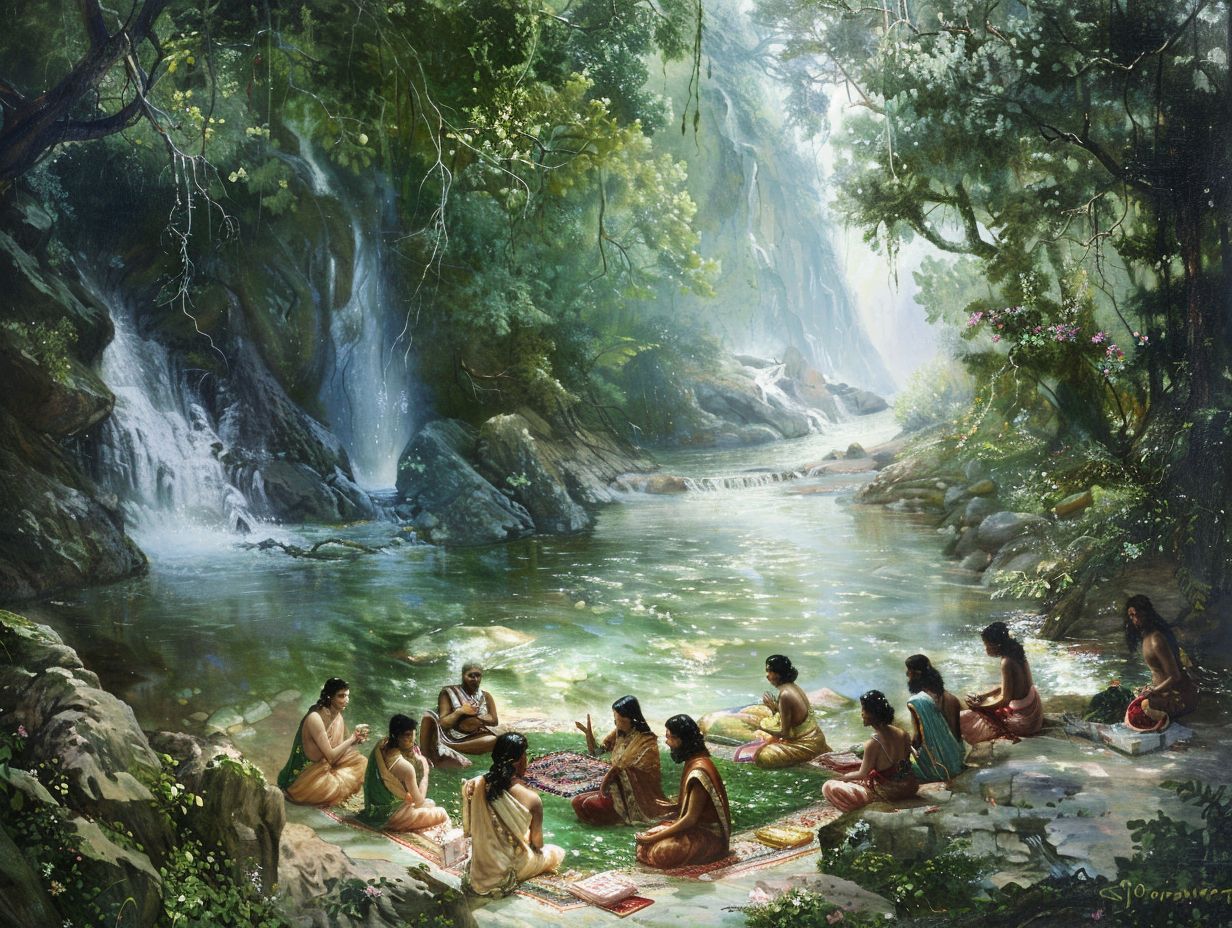Understanding Vishishtadvaita Philosophy
Vishishtadvaita philosophy, an esteemed school of thought within Hinduism, presents a rich tapestry of beliefs that intricately weave together devotion, self-understanding, and the nature of the divine.
At its essence, this philosophy highlights a qualified non-dualism, wherein the relationship between the individual soul (Atman) and the ultimate reality (Brahman) is both distinct and profoundly interconnected.
This exploration delves into the foundational principles of Vishishtadvaita, its revered texts, the pivotal role of devotion (Bhakti), and its unique perspectives on concepts such as Maya and Moksha.
Readers are invited to uncover the profound insights this philosophy offers into the depths of life and spirituality.
What is Vishishtadvaita Philosophy?

Vishishtadvaita, a prominent branch of Vedanta philosophy, offers a sophisticated perspective on the intricate relationship between the individual soul (Jiva) and the ultimate reality (Brahman), highlighting a balance between unity and diversity.
Established by the philosopher Ramanuja in the 11th century, this framework sets itself apart from both Advaita (non-dualism) and conventional dualism. It asserts that while each Jiva exists as a distinct entity within the cosmos, there exists an intrinsic connection to Brahman, the supreme deity.
This philosophy fosters a rich dialogue surrounding liberation (moksha), achieved through devotion (Bhakti) and ethical living, inviting deeper contemplation on the nature of existence and the path to spiritual fulfillment.
What are the Core Beliefs of Vishishtadvaita Philosophy?
The core tenets of Vishishtadvaita philosophy center around the intricate relationship between Brahman and Jiva, offering a profound understanding of God as both transcendent and immanent. This philosophy emphasizes the significance of devotion and ethical conduct in one’s spiritual journey.
Vishishtadvaita presents a distinctive view of the divine, depicting God not merely as a remote creator but as an ever-present force that permeates all aspects of existence. In this framework, the Jiva, or individual soul, assumes a pivotal role, embodying the essence of consciousness that strives for unity with Brahman.
Within this context, devotion emerges as a transformative practice, guiding individuals through their moral and spiritual challenges. By cultivating a deep, loving relationship with God, practitioners believe they can achieve a harmonious alignment with the universe, ultimately guiding them toward the liberation known as moksha.
Thus, the intertwining of devotion and ethical living weaves a vital thread in the rich tapestry of spiritual awakening.
Who is the Founder of Vishishtadvaita Philosophy?
Ramanuja, the distinguished philosopher and theologian of the 11th century, is celebrated as the founder of Vishishtadvaita philosophy, earning the esteemed title of Acharya due to his profound influence on Vedanta and the theological discourse within Hinduism.
His teachings underscored the importance of personal devotion and the intimate relationship between the individual soul and the Supreme Being, distinguishing his perspective from other philosophical traditions of his era. Through his interpretive works, particularly the ‘Sri Bhashya’, he provided a refreshing lens through which to view the Upanishads and the Brahma Sutras, championing a harmonious integration of devotion and knowledge.
This distinctive approach not only established a unique space for Vishishtadvaita but also inspired a rich lineage of thought leaders and scholars, nurturing a spirit of inclusivity within the broader tapestry of Hindu philosophy. Ramanuja’s emphasis on divine grace as essential for liberation continues to resonate, profoundly shaping the spiritual practices of countless devotees long after his time.
What are the Texts Used in Vishishtadvaita Philosophy?
The exploration of Vishishtadvaita philosophy is intricately linked to a rich tapestry of sacred texts, encompassing pivotal scriptures such as the Vedas, Upanishads, and the Bhagavad Gita. These texts offer profound insights and philosophical commentary that are crucial for a comprehensive understanding of its core principles.
What is the Importance of the Vedas in Vishishtadvaita Philosophy?
In Vishishtadvaita philosophy, the Vedas hold a position of unparalleled significance, serving as the cornerstone of sacred texts that encapsulate the essential spiritual knowledge and principles necessary for comprehending the nature of Brahman and the universe. These ancient scriptures not only unveil profound insights into metaphysical concepts but also illuminate the intricate relationship between the individual soul and the Supreme Being.
Adherents of Vishishtadvaita hold the Vedas in deep reverence as authoritative guides. They argue that these texts establish the legitimacy of its doctrines, which advocate a qualified non-dualism that harmonizes both the divine and the mortal realms.
The teachings contained within the Vedas engage with various philosophical frameworks, offering a distinctive perspective that reconciles with concepts from Advaita Vedanta and other schools of thought. This rich interplay enhances the understanding of devotion, inspiring practitioners to cultivate a loving relationship with the Supreme through a lens that honors the diversity of existence.
What Role do the Upanishads Play in Vishishtadvaita Philosophy?
The Upanishads hold a significant position within Vishishtadvaita philosophy, offering profound insights that lead practitioners toward a deeper understanding of Brahman, the soul (Atman), and the ultimate reality.
These ancient texts intricately explore the nuances of existence, shedding light on the interconnectedness of all beings while underscoring the importance of both individual and collective experiences within a vast cosmic framework. By examining themes such as non-duality and the dynamic relationship between the individual soul and the Supreme Soul, the Upanishads present teachings that resonate deeply with the principles of qualified non-dualism inherent in Vishishtadvaita.
In examining the connections between the Upanishads and other revered scriptures, such as the Bhagavad Gita and the Brahma Sutras, one discovers a rich tapestry of spiritual thought. This interplay enhances one s understanding of divine reality, ultimately guiding adherents toward a more profound realization of their own spiritual nature and purpose.
What is the Concept of Brahman in Vishishtadvaita Philosophy?

In the philosophy of Vishishtadvaita, Brahman is envisioned as the ultimate reality, encompassing both qualitative and quantitative attributes. This nuanced conception sets it apart from other philosophical interpretations of the divine, offering a distinctive perspective on the nature of God.
How is Brahman Different from the Concept of God in Other Philosophies?
The concept of Brahman within the framework of Vishishtadvaita philosophy presents a marked departure from the understanding of God found in other philosophical traditions. This distinction lies particularly in its recognition of both the transcendence and immanence of the divine within the universe.
In this philosophical perspective, Brahman is acknowledged as the ultimate reality while simultaneously retaining unique attributes, contrasting sharply with the often abstract and formless conception of the divine in Advaita Vedanta. In Advaita, God is frequently regarded as an impersonal entity, stripped of distinctions. This creates a striking contrast with Vishishtadvaita’s portrayal of a personal God, who engages intimately with creation.
Such differences significantly influence the approach to spirituality and devotion. Practitioners of dualistic philosophies may find themselves engaging with the divine through personal worship and relationships, perceiving the divine as both a seer and the seen. This contrasts with the view of the divine as an indistinguishable essence, enriching the spiritual journey with a sense of connection and intimacy.
What is the Role of Atman in Vishishtadvaita Philosophy?
In Vishishtadvaita philosophy, the concept of Atman is understood as the individual soul, which, while distinct, is fundamentally interconnected with Brahman. This relationship plays a crucial role in the pursuit of liberation (moksha), emphasizing the importance of devotion and ethical conduct in one s spiritual journey.
How is the Concept of Atman Different from the Concept of Soul in Other Philosophies?
The concept of Atman within the framework of Vishishtadvaita philosophy presents a nuanced departure from the traditional understanding of the soul as seen in various other philosophical systems, particularly regarding its emphasis on the intricate relationship between the individual soul and the ultimate reality of Brahman.
In Vishishtadvaita, the individual Atman is perceived as a distinctive manifestation of the divine, encapsulating both individuality and a profound unity with Brahman. This perspective stands in stark contrast to the rigid distinctions often found in dualistic frameworks, where the soul is depicted as fundamentally separate from a creator or ultimate being.
Such a viewpoint underscores an intrinsic interconnectedness, positing that a thorough comprehension of personal identity necessitates an acknowledgment of the soul’s inseparable connection to the divine. In contrast, non-dualistic traditions redirect their focus towards the notion that individual identity is, in fact, an illusion. This realization leads to divergent implications for spiritual liberation, wherein the objective shifts to dissolving personal identity into a singular, universal consciousness.
What is the Relationship Between Brahman and Atman in Vishishtadvaita Philosophy?
In Vishishtadvaita philosophy, the relationship between Brahman and Atman is marked by a profound interplay of unity and diversity. This perspective posits that while Atman retains its distinctiveness, it ultimately represents an integral aspect of the overarching reality known as Brahman.
How is the Relationship Between Brahman and Atman Explained in Vishishtadvaita Philosophy?
In Vishishtadvaita philosophy, the relationship between Brahman and Atman is articulated within a framework that acknowledges the individuality of the soul while affirming its intrinsic connection to the divine reality of Brahman. This intricate interplay asserts that each individual soul, or Atman, is both distinct and an integral part of a greater whole, embodying a dualism that honors the uniqueness of every being while underscoring a shared essence with Brahman.
The philosophy encourages practitioners to delve into the unity that exists beneath the surface of apparent diversity, suggesting that spiritual practice entails recognizing this profound interconnectedness. Through devotion and surrender, one can experience the fundamental unity of existence, understanding that while each soul may traverse its own path, the ultimate destination remains a return to the source.
This realization fosters a deeper comprehension of both personal identity and the universal oneness that binds all.
How Does Vishishtadvaita Philosophy View the Concept of Maya?

In the realm of Vishishtadvaita philosophy, Maya is perceived as the veil that shrouds the true essence of reality. This illusion poses significant challenges for individuals striving to comprehend their relationship with Brahman and to navigate the intricate complexities of the universe.
What is the Role of Maya in the Manifestation of the Universe According to Vishishtadvaita Philosophy?
Maya occupies a pivotal role in the manifestation of the universe within the framework of Vishishtadvaita philosophy, acting as the veil that conceals the ultimate reality of Brahman and fostering a perception of diversity and separation.
This philosophical viewpoint posits that although the material world presents itself as diverse and replete with distinct forms, it is ultimately an illusion that shapes human experience. By highlighting the transient nature of worldly phenomena, Maya encourages individuals to look beyond superficial differences and recognize the underlying unity that permeates all beings.
Such understanding cultivates a profound spiritual realization, prompting practitioners to transcend their limited perceptions and engage in a deeper inquiry into their true essence.
Thus, the role of Maya not only elucidates the intricate complexities of existence but also paves a pathway toward liberation through self-awareness and devotion.
What is the Ultimate Goal of Vishishtadvaita Philosophy?
The ultimate aim of Vishishtadvaita philosophy is the attainment of moksha, or liberation. This profound state is realized through unwavering devotion (Bhakti) to Brahman, coupled with ethical conduct, ultimately guiding the individual toward a direct experience of the divine.
How Does Vishishtadvaita Philosophy View the Concept of Moksha?
In the philosophy of Vishishtadvaita, moksha is regarded as the ultimate liberation from the relentless cycle of birth and death, achieved through sincere devotion and dedicated service to Brahman, coupled with the realization of profound knowledge.
This liberation transcends mere escape from worldly suffering; it represents a profound union with the divine essence. Devotees embark on their spiritual journey through various practices such as bhakti (devotion), the study of sacred scriptures, and the performance of selfless service, each of which deepens their connection to Brahman.
By engaging in rigorous ethical conduct and cultivating a sense of surrender, the devotee works to diminish the ego, thereby facilitating personal transformation. Through these practices, individuals may experience a gradual awakening, drawing ever closer to the realization of moksha, where the soul merges with the divine, transcending all earthly limitations.
What are the Practices and Rituals Associated with Vishishtadvaita Philosophy?
The practices and rituals inherent in Vishishtadvaita philosophy weave a rich tapestry of devotion (Bhakti), worship, and ethical conduct, all meticulously designed to cultivate a profound connection with Brahman while simultaneously encouraging active engagement within the community.
What is the Importance of Bhakti (Devotion) in Vishishtadvaita Philosophy?
Bhakti, or devotion, occupies a pivotal role in Vishishtadvaita philosophy, esteemed as the primary avenue through which individuals establish a connection with Brahman and aspire for liberation.
In this tradition, the practice of Bhakti transcends mere ritualistic worship, evolving into a profound emotional and spiritual odyssey. Devotees engage in various expressions of loving service and cultivate a personal relationship with the divine, perceiving Brahman as a caring personal God deeply invested in their well-being.
This profound connection not only nurtures inner peace but also transforms the devotee s entire existence. The transformative power of Bhakti enables individuals to transcend ego and desires, ultimately guiding them toward a harmonious unity with Brahman.
As practitioners nurture qualities such as love, gratitude, and surrender, they frequently encounter significant emotional healing, enlightenment, and a sense of community with fellow devotees, emphasizing the collective journey toward liberation.
What Role do Scriptures and Prayers Play in Vishishtadvaita Philosophy?

In Vishishtadvaita philosophy, scriptures and prayers hold a vital position, serving as both guiding texts and rituals that enhance the spiritual journey and deepen one’s connection with Brahman.
Traditionally attributed to the esteemed theologian Ramanuja, these texts encompass a rich array of philosophical discourses and devotional hymns. The Vedas, Upanishads, and Bhagavad Gita are central to this practice, each providing profound insights into the nature of reality and the divine.
Prayers function as a bridge, facilitating intimate conversations with Brahman and allowing practitioners to articulate their devotion and surrender. By engaging with these sacred scriptures and prayers, individuals cultivate a sense of belonging within the cosmic order, ultimately enabling them to experience divine grace in a more tangible way in their daily lives.
Frequently Asked Questions
What is Vishishtadvaita philosophy?
Vishishtadvaita, also known as qualified non-dualism, is a school of Hindu philosophy that emphasizes the existence of an ultimate reality (Brahman) and the individual soul (Atman) as distinct but interconnected entities.
Who is the main proponent of Vishishtadvaita philosophy?
The main proponent of Vishishtadvaita philosophy is Ramanujacharya, a Hindu theologian and philosopher who lived in the 11th and 12th centuries in South India.
What are the key principles of Vishishtadvaita philosophy?
The key principles of Vishishtadvaita philosophy include: the existence of an ultimate reality (Brahman), the individual soul (Atman) as a part of Brahman, the concept of devotional surrender (prapatti), and the belief in the interconnectedness of all beings.
How does Vishishtadvaita philosophy differ from other schools of Hindu philosophy?
Vishishtadvaita differs from other schools of Hindu philosophy, such as Advaita and Dvaita, in its belief that the individual soul is not completely identical to Brahman, but rather exists as a part of Brahman and maintains its individuality.
What is the role of devotional surrender in Vishishtadvaita philosophy?
Devotional surrender, also known as prapatti, is a central concept in Vishishtadvaita philosophy. It is the belief that through complete surrender and devotion to God, one can attain moksha (liberation) and become united with Brahman.
How can one apply the teachings of Vishishtadvaita philosophy in daily life?
One can apply the teachings of Vishishtadvaita philosophy in daily life by cultivating a sense of interconnectedness and unity with all beings, practicing devotion and surrender to God, and striving for self-realization and ultimate liberation through spiritual practice and selfless service.
